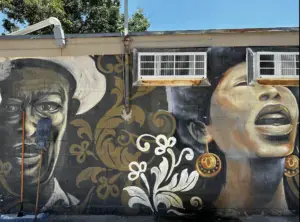
The Impact of Gentrification in Austin | What Once Was
 Written by: Ben Perez
Written by: Ben Perez
Edited by: Elisa Calderon
The Impact of Gentrification in Austin and How to Take Action
Gentrification is a term that has become increasingly prevalent in urban discussions, especially in Austin. In this blog post, we’ll delve into the changing face of Austin through the lens of gentrification—understanding the history, exploring its impacts, examining how the city is addressing this issue, and the ways we can individually and collectively respond.
Examples of Gentrification in Austin
The gentrification of Austin is complex, with various neighborhoods experiencing different degrees of transformation. For example, South Congress Avenue, at one point a hotspot of local establishments and artistic expression, has seen a surge in more upscale developments in recent years, which has led to the pushing out of smaller businesses. The East Cesar Chavez neighborhood has also witnessed rising property values and the influx of affluent residents, displacing long-time and majority BIPOC residents. For a more comprehensive description of gentrification, check out our blog “What is Gentrification?” There, you can gain a better understanding of the complex realities of gentrification and how they impact neighborhoods.
The History of Gentrification in Austin
Austin’s Freedom Colonies
To understand the roots of gentrification in Austin, we should acknowledge the city’s history of freedom colonies. A few examples of these communities in Austin include Wheatville, Clarksville, and Montopolis. These were self-sufficient communities established by the Black community after Emancipation in 1863. Over time, some of these colonies faced challenges due to urban development, resulting in the erosion of their cultural identity.
The Rise and Fall of East Austin
East Austin, historically a hub for BIPOC communities, has undergone significant changes as Austin expands and gentrifies. Once a bold center of Black and Latinx culture, the pressures of gentrification have displaced and erased much of the cultural heritage and presence once found here. Facing skyrocketing property values, long-time residents found themselves unable to keep up with rising costs, leading to a transformation that has left parts of East Austin virtually unrecognizable from what it once was.
Affordable Housing and Property Taxes
Gentrification usually intertwines with local government policies. In Austin, the issue of affordable housing has been exacerbated by policies that favor upscale developments. City council and city leaders are not unaware of gentrification and the housing crises in our city. A recent development is the passing of Phase 1 of the controversial HOME Proposal, which proponents say will ease the housing crisis but opponents argue will further gentrify certain neighborhoods in East Austin. Additionally, the impact of property taxes on long-time residents has been profound, contributing to the displacement of communities as they struggle to keep up with rising costs of living in their neighborhoods. For a more in-depth exploration of the causes of gentrification, read our blog “What Causes Gentrification?”
How Do You Know If Your Neighborhood Is Being Gentrified?
Identifying the signs of gentrification is key for residents to advocate for their communities and neighborhoods. In Austin, rising property taxes and a shifting housing supply are key indicators that an area is undergoing gentrification. Identifying and understanding these signs empowers residents to take proactive steps to preserve the character of their neighborhoods and protect their livelihoods.
What Can You Do to Combat Gentrification in Austin?
Taking Action
Combating gentrification requires collective action. Residents can engage in local initiatives, vote for policies that prioritize socio-economic diversity, and support organizations working to preserve cultural heritage. Organizations like E4 Youth and our sister nonprofits are actively involved in these efforts, providing opportunities for individuals to contribute through donations, partnerships, and working to preserve the cultural history of Austin. For a closer look at our work in cultural preservation, check out the What Once Was platform.
The gentrification of Austin is deeply rooted in its history and shaped by various factors. Understanding the nuances of this phenomenon is crucial for residents and city leaders alike to work towards a more inclusive and sustainable future for all Austin residents.

